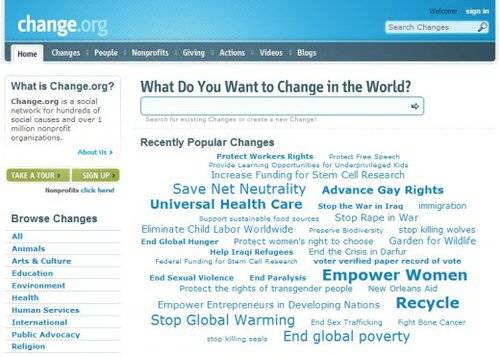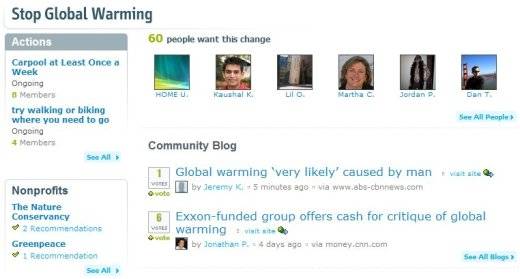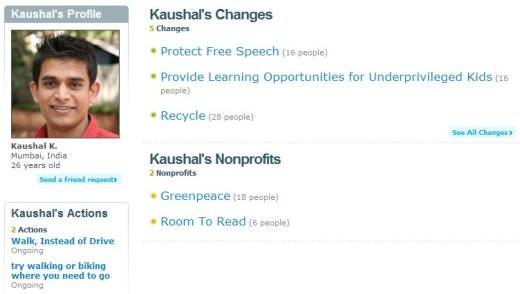Yet another social network
launched publicly today, but this one called Change.org
caught my eye for a couple of reasons. Firstly it’s for a great cause – enabling people
to form communities around social issues like global warming and Net Neutrality. But it’s
also a very well designed site that makes excellent use of ‘web 2.0’ technologies.

The first thing that you notice when you visit the homepage of Change.org is the
tagcloud, which draws attention to the top issues in the network. The tagcloud constantly
updates, but as of writing ‘Empower Women’ and ‘Recycle’ were the top tags. To get a feel
for the site I clicked on ‘Stop Global Warming’, a hot topic currently (pun intended)…

As of writing there are 60 people who want to effect the change of stopping global warming – a number which will
certainly increase a lot as Change.org gathers momentum. There are a good number of tools
available for people to discuss and effect this change – community blog, comments on “Why
Do You Support this Change?”, videos, photos, Message Boards, “giving networks”, lists of
related nonprofits, “Actions” (e.g. “Carpool at Least Once a Week”), and even a mapping component. But as
with all social networks, it’s the people who are the center of the site.

Clicking through to one user (and note you need to be signed in to do that) displays their profile and the causes they support. There is also an option to “Send a friend request”. I
presume the idea is that you find people supporting similar causes to you – and that’s
how the networking occurs. In the case of Change.org though, there is a higher purpose
than simply chatting online to new friends. You’re also supporting social causes – a.k.a.
“changes” in the lingo of this site. What’s more, clicking through on user profiles
allows you to discover new social causes to support. It’s certainly a neat idea
all round and very nicely implemented in terms of web design and use of ‘web 2.0’
techniques.

The founder of Change.org is Ben Rattray from San Francisco, who told me in an email
that they’ve signed up “several dozen of the largest nonprofits in the world –
including Amnesty International, Oxfam, and Greenpeace”. So the site is already well
supported. Ben said the aim of the site is to enable people to collectively advance
change on a variety of issuues. So they built a platform that connects people, whatever
their interest, and enables them “to exchange information, share ideas, and collectively
act to address the issues they care about.” He also noted that Change.org connects people
to existing nonprofits – essentially to create a social network around each nonprofit
(more than 1 million in total). Ben thinks this will allow people “to participate in
these organizations in a way never before possible – by posting ideas and
suggestions, engaging in direct dialogue, and organizing communities of donors, volunteer
opportunities, etc.”
Overall, I’m impressed by the goals of Change.org and also the implementation. This is
almost a textbook example of how web 2.0 technologies can be deployed on a website. Go
check it out…

















